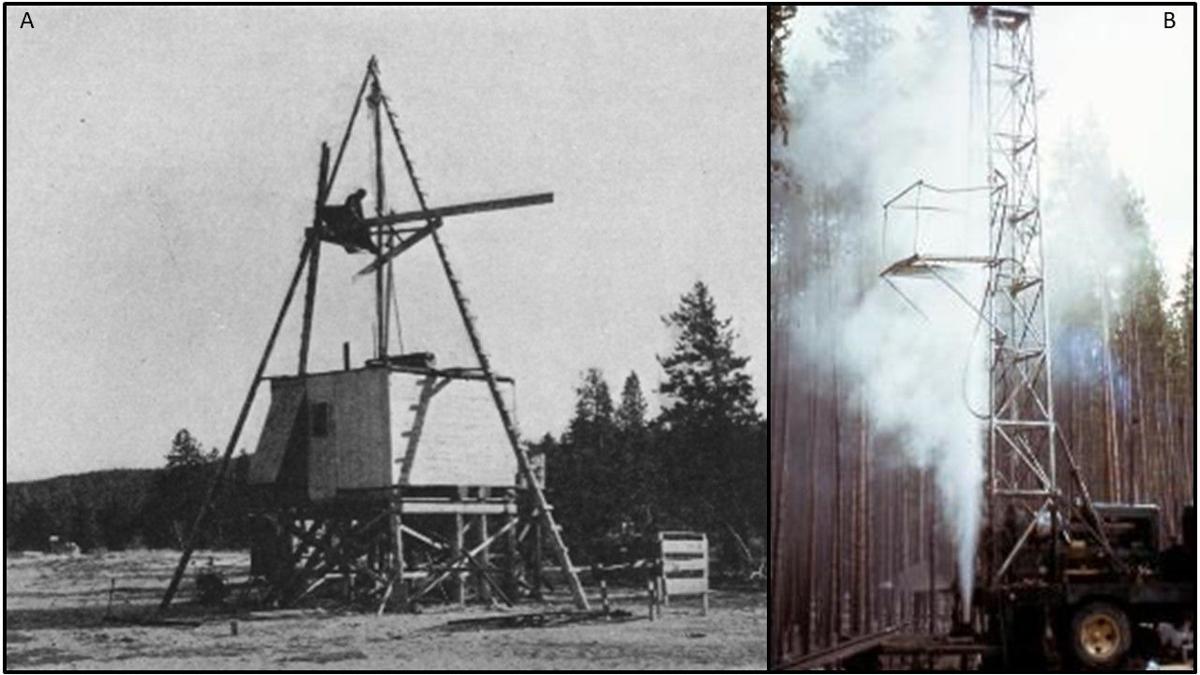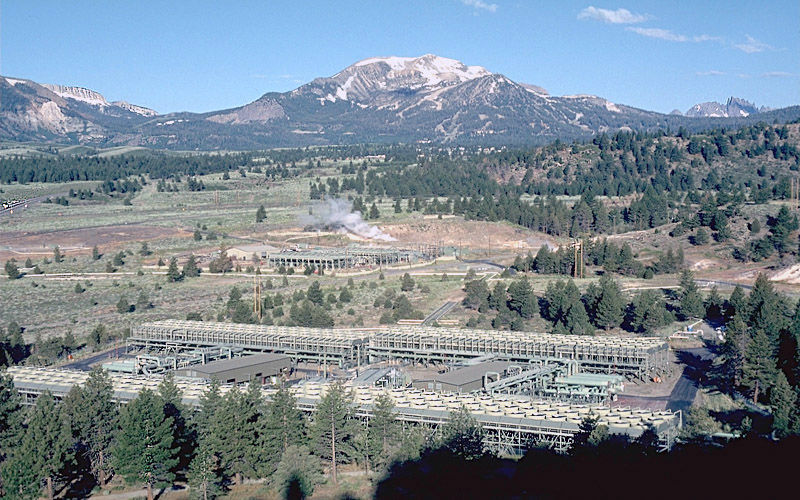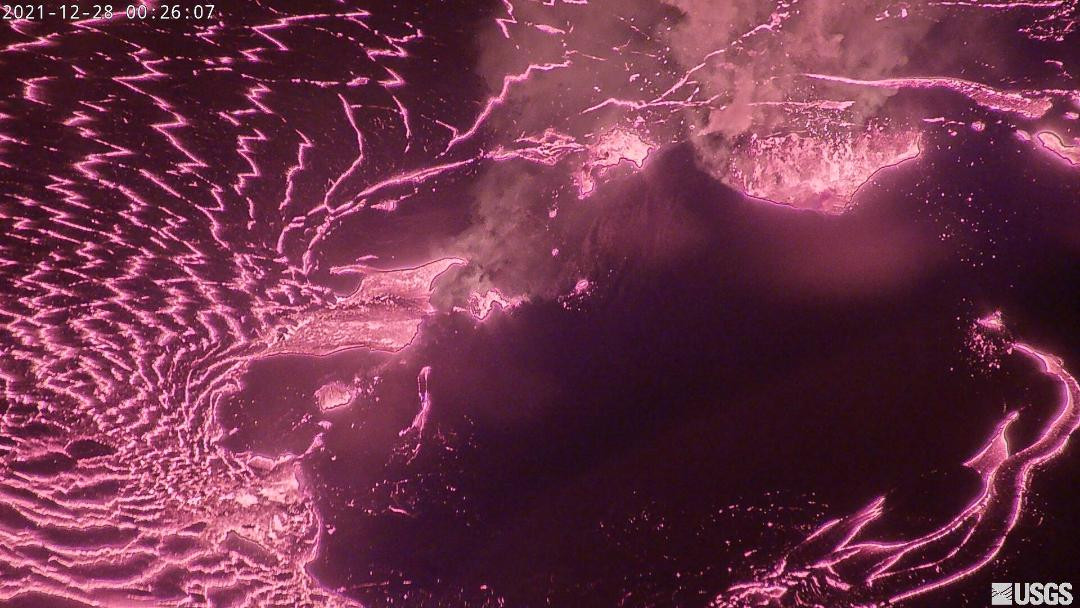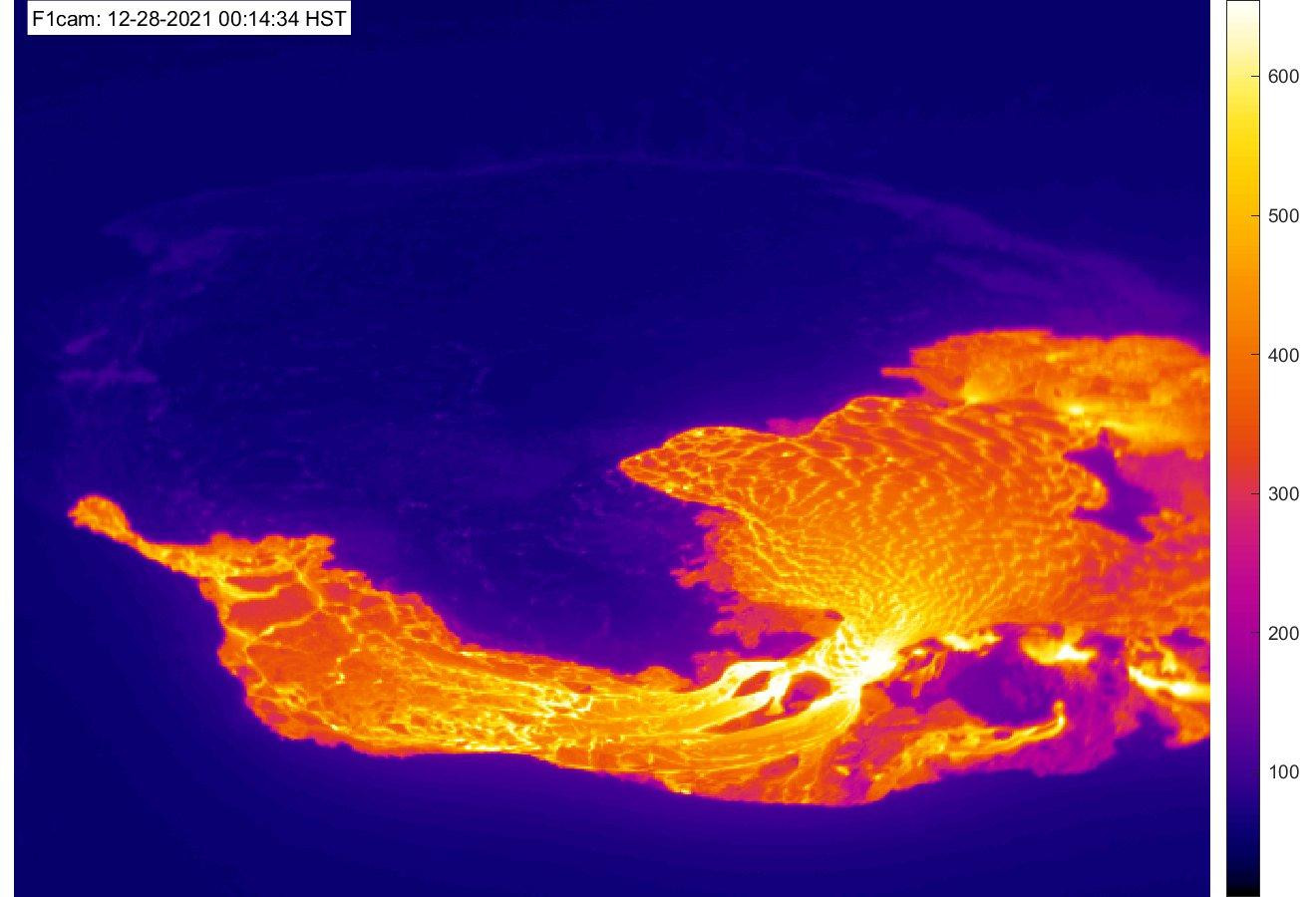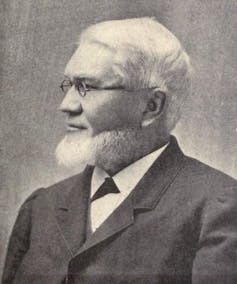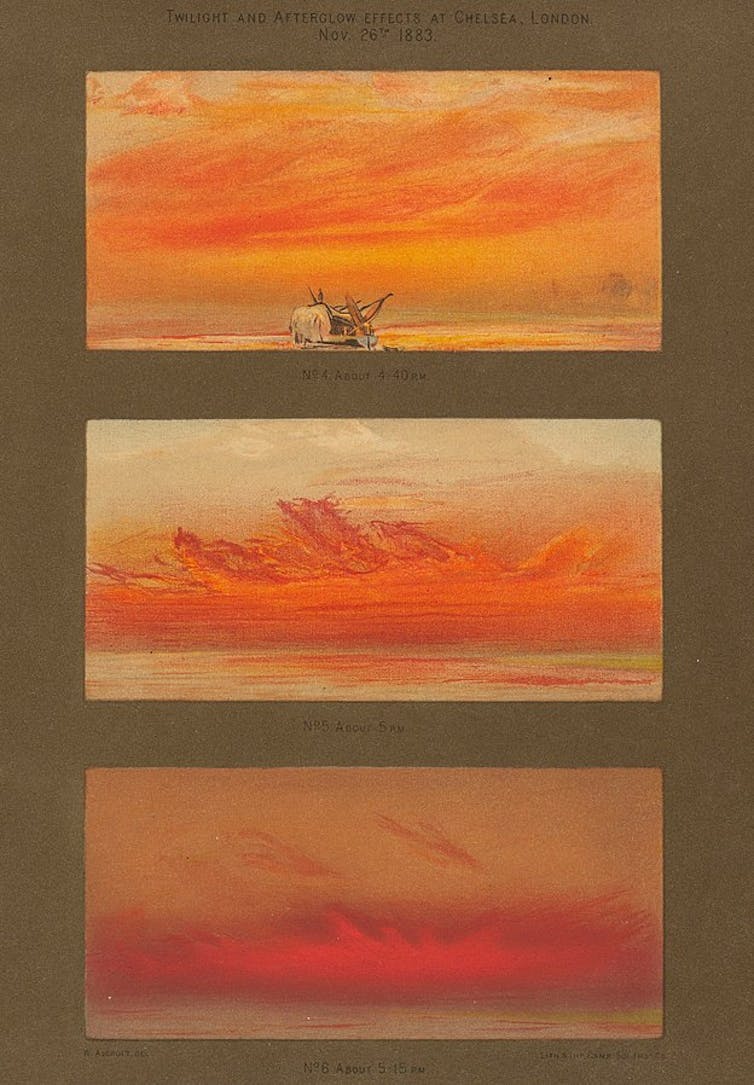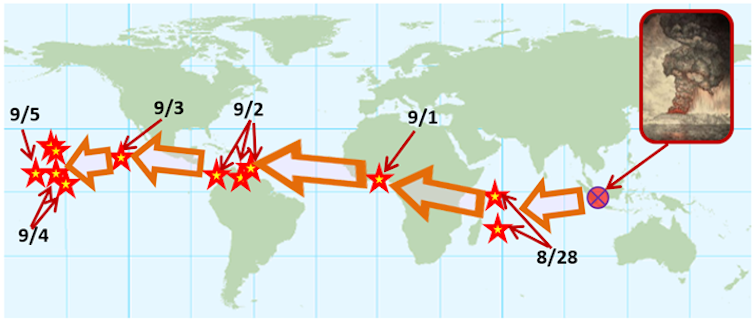Volcanoes can pave their surroundings with lava, send clouds of hot ash downslope to smother cities, and even generate massive tsunamis. The most recent high-profile eruption on the Canary Islands spawned viral videos of slow, steady folds of smoldering lava enveloping houses and swimming pools.
A volcano’s plume, such as this one from the 2009 Sarychev Peak eruption on the Kuril Islands in the Russian Far East, can send long-distance signals that indicate an eruption has occurred. Image credit: NASA/Mike Barratt (photographer).
But the perils volcanoes pose aren’t limited to ground level: Their ash plumes threaten aircraft passing overhead, even those flying at cruise altitude. In the case of a sudden and explosive eruption, those clouds of ash—which are in fact small bits of rock—can reach elevations of 10,000 meters in just a few minutes.
Despite these impressive displays, volcanic eruptions, especially remote ones situated far away from seismic instruments, can be hard to detect. There are some clues: Plume-induced lightning often betrays the presence of ash clouds once they’ve reached high altitude. But recent studies suggest that a different kind of electrical discharge—one generated near the base of a volcanic plume and nowhere else—could provide researchers with a heads-up that an eruption has commenced. Another analysis hints that other unseen signals, the low-frequency warbles known as infrasound, could help researchers monitor changes in ongoing eruptions that signal danger for people nearby.
Danger in the Air
Dozens of aircraft have had run-ins with plumes of volcanic ash, although none of these encounters has been fatal. One of the most dramatic encounters occurred in December 1989 when KLM flight 867 from Amsterdam ran into an ash cloud as it approached its destination in Anchorage, AK. Ash sandblasted the plane’s windshields; airspeed sensors began to give false readings and then failed. All four engines died; the plane lost more than 3 kilometers of altitude before pilots could restart them. Although the pilots landed the 747 safely, it took more than $80 million to replace the engines and rehab the plane.
Researchers have long noted that many volcanic plumes, especially large ones, generate lightning. And strokes of lightning—especially the long, powerful ones—are often detected by the same network of sensors that meteorologists use, explains Stephen McNutt, a volcanic seismologist at the University of South Florida in Tampa. As a result, this lightning has often served as a sign of an eruption. Of course, that lightning could just as easily serve as a sign of a garden-variety thunderstorm.
But volcanoes produce other sorts of electrical discharges too—some of which are, as far as researchers know, unique to volcanoes, says McNutt. In recent years, this type of lightning has intrigued researchers.
All Charged Up
Whatever the type of discharge, it stems from phenomena taking place at the base of the ash plume. There, ash particles get electrically charged in two ways. One occurs when the particles first form. As molten rock spews into the air at high speed, it breaks into droplets, just as a turbulent stream of water from a garden hose does. Although the torrent of molten rock starts out electrically neutral overall, individual particles of ash that solidify can end up either positively or negatively charged as they break apart, occasionally carrying unequal numbers of charges with them. A second way that ash particles get charged is by rubbing against each other at high speed—a geological version of shuffling one’s shoes on the carpet.
Lab studies have suggested that larger particles of ash tend to gain positive charges, whereas smaller ones end up negatively charged (1). And in the chaotic jumble of an ash plume, those charged particles can get separated. Researchers found that smaller particles tend to end up on the periphery of the plume, whereas the large ones tend toward the center. Also, lighter, negatively charged particles are buoyed more effectively than the heavier, positively charged ones. In portions of the plume far from the volcano, charges can spread far apart, says McNutt. At the base of the plume, charged particles are necessarily close together. Regardless of the distance, however, electrical fields can grow only so strong before they overwhelm the air’s ability to prevent discharges.
At distances of one kilometer or more from the volcano, researchers have noted, these discharges typically take the form of full-fledged lightning bolts that can extend several kilometers or more. The discharges also generate brief yet prodigious pulses of radio waves—which anyone who listens to AM radio near a thunderstorm can recognize as loud bursts of static. Large numbers of aptly named “vent discharges” occur much closer to the volcano at the base of an ash plume and generate a near-constant crackle of radio waves, which researchers have dubbed continual radio frequency (CRF) emissions. In 2014, McNutt and a colleague described how lightning observations, both of large bolts and CRF, could be used to monitor volcanic eruptions (2). Whereas large bolts emit a lot of low-frequency energy and can be detected over long distances, says McNutt, CRF emissions occur at higher frequencies and can only be discerned by line-of-sight observations.
Since then, researchers have learned much more about volcanic lightning. Field work around Japan’s Sakurajima volcano in 2015 showed that individual CRF discharges are extremely brief, typically lasting no longer than 160 nanoseconds—which, in turn, indicates that the discharges extend no more than 10 meters (3). Subsequent analyses of data gathered during 97 small eruptions from the volcano during one 7-day stretch showed that, in general, lightning bolts were generated at higher altitudes during eruptions that spewed a lot of material (4). CRF emissions, on the other hand, were generally produced during high-speed eruptions at altitudes much closer to the vent, says Cassandra Smith, a geoscientist at the Alaska Volcano Observatory in Anchorage.
Although CRF discharges are readily betrayed by their radio emissions, it’s not clear whether they’re visible or not. No one has captured any of them in photos or on video, says Smith—the discharges are small, brief, and likely almost always well hidden inside the ash-rich plume.
Because these mysterious CRF emissions occur at the base of volcanic ash plumes and nowhere else, they could play an important role in providing early warning for explosive eruptions. Lightning detectors that are set up within 100 kilometers of an erupting volcano and have a direct line of sight to the peak should be able to detect CRF, Smith notes.
The ultimate goal is to use existing networks of seismic and other instruments to guide researchers’ placement of CRF sensors near peaks that show initial signs of rumbling to life, says Alexa van Eaton, a volcanologist at the Cascades Volcano Observatory in Vancouver, WA. Detecting CRF emissions would signify the beginning of an eruption, and if those signals continue for a lengthy period, this would suggest that an ash plume may be rising to altitudes where aircraft fly.
The Sound of Silence
Erupting volcanoes have another intriguing, hidden characteristic that may not only provide insight into eruptions but perhaps also help researchers monitor ongoing volcanic activity. Eruptions produce prodigious amounts of infrasound—frequencies that lie below 20 Hertz, the threshold below which the human ear can’t detect sound. Nevertheless, these warbles can provide researchers with plenty of clues about what’s going on in or near an erupting volcano.
In late 2016 and early 2017, an undersea volcano in the Aleutian Islands erupted more than 70 times over the course of 9 months. Owing to the lack of seismometers on the submerged peak, researchers at the Alaska Volcano Observatory depended on infrasound data, gathered at six sites ranging from 59 to more than 800 kilometers from the peak, to monitor its activity, says Matthew Haney, a geophysicist at the facility. Unlike the radio waves generated by lightning and other discharges, infrasound travels relatively slowly: It took about 3 minutes for sound to travel from the volcano to the nearest array of microphones. And as a result of varying weather conditions and wind speeds, none of the eruptions was detected by all six infrasound arrays, Haney notes.
But the team’s observations nevertheless yielded first-of-their-kind insights into Bogoslof’s volcanic activity. Early in the series of eruptions, when the peak lay beneath several tens of meters of seawater, infrasound generated by the eruptions was dominated by frequencies between 0.1 and 1 Hertz, the researchers reported (5). That low-frequency infrasound largely stemmed from the growth, oscillation, and rupture of giant gas bubbles as they broke the surface of the sea, says Haney. But after the peak breached the surface of the ocean, eruptions spewing directly into the atmosphere generally produced higher-frequency infrasound.
“We can learn a lot about the processes going on inside ash plumes even for small eruptions. But for now, the part we want to know is right outside our grasp.”
—Stephen McNutt
Field work at Italy’s Stromboli volcano during eruptions in 2018 and 2019 has reinforced the utility of sonic observations. There, a team used high-speed video and recording of low-frequency sound, as well as infrasound, to study vortex rings within an ash plume generated by sudden bursts of volcanic activity (see, for example, https://www.youtube.com/watch?v=2vUIzcvkaec). These swirling, doughnut-shaped vortices look something like the smoke rings puffed toward the ceiling by a cigarette smoker, explains Jacopo Taddeucci, a volcanologist at Italy’s National Institute of Geophysics and Volcanology in Rome.
Altogether, the team analyzed 26 vortex rings. Using data captured at speeds up to 1,000 frames per second, the researchers could pin down the position of flying lava blobs within a couple of centimeters or less, says Taddeucci. By pairing these data with images gathered by a drone flying over the peak, the researchers found that they could use the smoke ring data alone to estimate both the diameter of the vent as well as the speed of material spewing from it—and this can then be used to estimate the distance that lava bombs might travel from the vent (6).
Besides providing a better understanding of the basic physics of volcanoes, the new findings can improve safety for researchers as well as tourists hiking near an erupting peak, says Taddeucci. When there are people nearby, he notes, “it is important to notice changes in eruptions very quickly.”
Regardless of whether researchers focus on volcanic lightning or infrasound, “we need more field data from more eruptions,” says McNutt. That, in turn, will require more active peaks to be surrounded by broader networks of sensors of all types, he notes.


